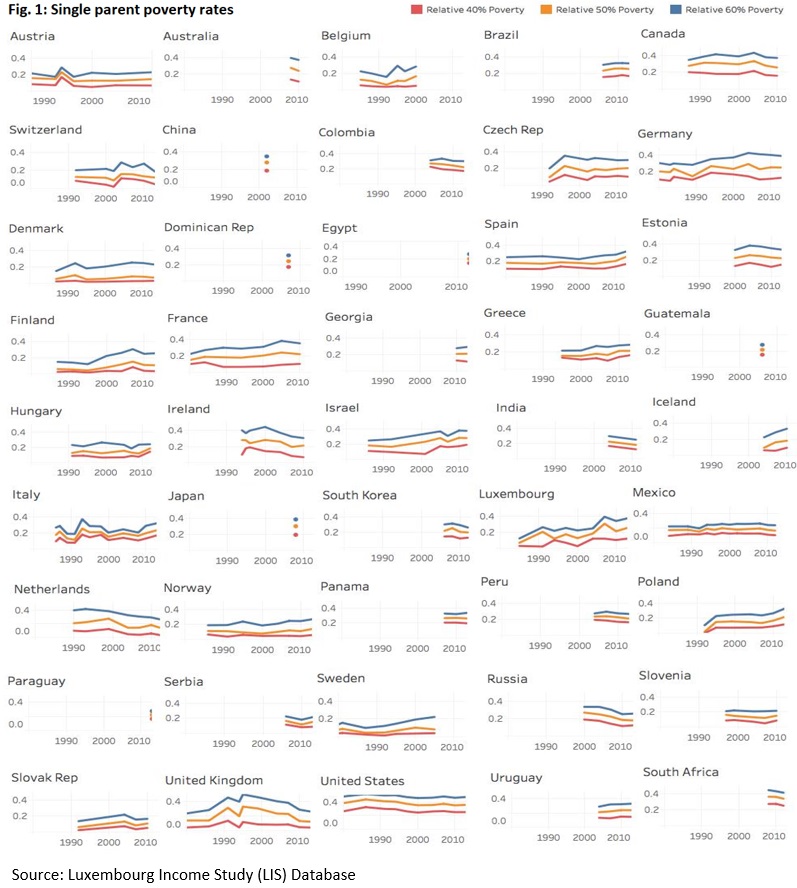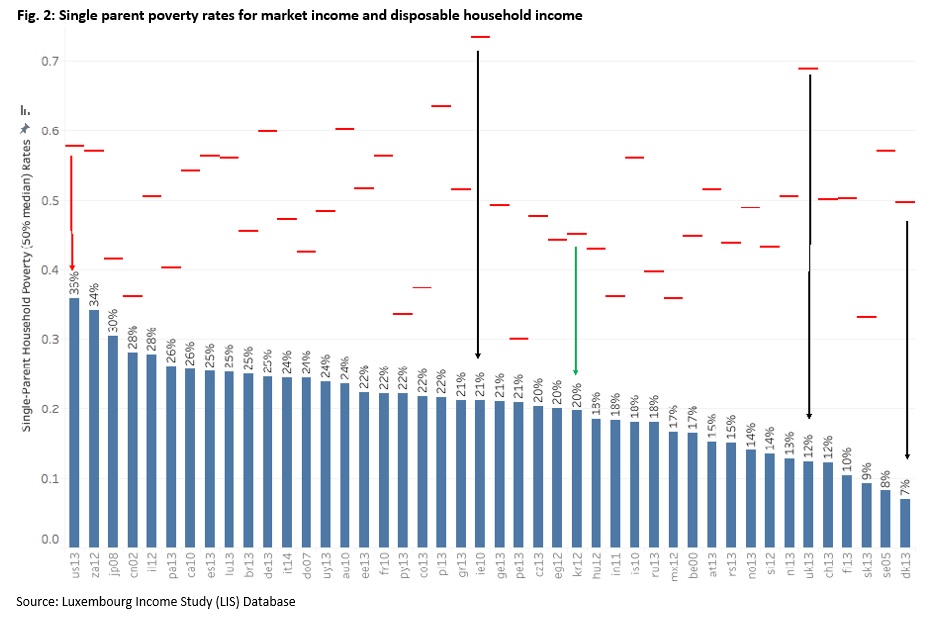Issue, No.5 (March 2018)
Doing better for single-parent families, the US compared to 45 countries
The debate as to whether single-parent families are the cause or consequence of poverty and inequality is widespread. In the United States, it is often a topic of conversation and heated debate at the dinner table. Jason DeParle (2012) wrote in the New York Times an article titled “Two Classes in America, Divided by ‘I Do’” suggesting that above else, the cause of poverty is the result of women’s poor choices of selecting a partner. That inequality between single-and coupled-parent families has much to do with the individual choices of single parents. In response, Bryce Covert (2013) wrote in Forbes magazine an article titled “Bad Relationships Don’t Stand in Poor Women’s Way. Bad Policies Do”. Covert argued, “The problem isn’t who single mothers decide to date. It’s the way the US government fails to support them”. She argued for the US to learn from other countries and how their social policies support single-parent families. Recently (2018), David Brady, Ryan Finnigan, and Sabine Hübgen, wrote an op-ed in the New York Times titled “Single mothers are not the problem”. Their article also supports this position. Their study, used the Luxembourg Income Study (LIS) data, finds that the prevalence of single mothers has little to do with poverty and more to do with a lack of generous policies. Generous policies, like in Denmark, address penalties and consequently these countries have much lower poverty rates.
This brief also uses the LIS data to examine single-parent families and policies that reduce poverty across countries. It’s part of my dissertation titled “Doing Better for Single-Parent Families, Poverty and Policy in 45 Countries” (Maldonado, 2017; please refer to this monograph for more details, methods, and rationale). This short piece will: 1) describe poverty rates of single-parent families across countries and over time, 2) analyze the impact of taxes and transfers on reducing poverty, 3) summarize the findings of socio-demographic characteristics and parental leave policy on reducing poverty in a multi-level model, and 4) provide suggestions for how the US can do better for single-parent families.
Descriptive results
In 45 countries, about 1 in 5 families are single-parent families. Single-parent households are defined as having one adult living with his/her child(ren) under the age of 18. Other adults can reside in the same household, such as grandparents, but not partners. Prevalence of single-parent families has been increasing over time for the majority of countries. The majority of single parents are mothers and many are working. Even in countries with lower overall employment rates, the average employment rate for single parents is still high at 66 percent. Even though the majority of single parents are employed–because they have no other choice but to work– their families remain at great risk for poverty.

The United States has the highest percentage, 36 percent, of single-parent families in poverty of all countries. More than 1 in 3 single-parent families is poor in the US. Not only does the US stand out as the “Worst-Off” for single parents in high-income countries (Casey and Maldonado, 2012) but it deserves this same deployable title among many middle-income countries as well; including South Africa, China, Panama, and Brazil. At the 50 percent threshold, the US along with South Africa, Japan, Canada, Germany, Israel, Luxembourg, Spain, China, Panama, and Brazil– have poverty rates above 25 percent. Denmark, on the other hand, has much lower poverty rates, 7 percent of single-parent families were poor.
Approximately 1 in 4 single parents and their children, 25 percent, experience deep poverty in both US and South Africa. The American story is told in Edin and Shaefer’s (2016) $2.00 a Day Living on Almost Nothing in America. The rise of deep poverty and material deprivation have put families in dire consequences without adequate support from a social safety net.
The trends show that poverty is increasing in some countries while decreasing in others. For example, poverty is increasing in Finland and Iceland which are Nordic countries with typically have lower poverty rates but here the rates for single parent poverty have been increasing in recent years. Ireland and the UK have drastically reduced their poverty rates over time. The Netherlands also shows a notable trend in decreasing poverty over time, especially declines at the 60 percent threshold, near-poverty.
Pre-and Post-taxes and transfers
Before all taxes and transfers are accounted for, the US poverty rate is quite similar to countries like Denmark and Sweden. But after all taxes and transfers are accounted for, these countries effectively redistribute income and the US is left behind with persistently high poverty rates. Whereas the United States only reduced poverty from 58% to 36%, for a total of 22 percentage points, it remains the highest percentage of single parent in poverty of all countries. Denmark reduced poverty from 50% to 7%, a total of 43 percentage points. UK and Ireland have significantly reduced poverty by 57 and 52 percentage points, respectively.
An important insight: all 45 countries redistribute income to reduce poverty. Most countries redistribute income to cut their poverty rates by half or more. Even countries that are traditionally known for less redistribution in general, for instance South Korea, still redistribute income to single-parent families. Redistribution through taxes and transfers is very effective in reducing poverty for single-parent families in all countries.
Not only is redistribution effective, family transfers are particularly important for single-parent families. Ireland and the UK are effective in redistributing income to single-parent families, they do so by way of family transfers. Some of these countries have lower poverty rates to begin with, but still effectively use family transfers to reduce poverty by more than half.
Multi-level policy results
The multi-level analyses examined 373,032 households with children in 45 countries with most recent data sets, using household-level data from the LIS and country-level policy indicators from The WORLD Policy Analysis Center. The sample included single-parent households and coupled-parent households. The dependent variable was poverty at 50 percent of the median equivalized disposable household income.
The multilevel analyses accounted for demographics, employment, and policy (leave for moms and leave for both parents). Socio-demographic characteristics contribute to poverty risk. Single parents have a much higher poverty risk as compared to coupled parents. Heads of the household who are older and have higher level of education have resources that protect their families from poverty risk. Families that have one or more children under the age of 5 have greater poverty risk, and even greater risk if the number of young children is increased. However, when demographic factors were controlled for in the model, the country institutional effects were more consequential determinants of poverty. Employment significantly reduced poverty. Paid maternity leave significantly reduced poverty for single-parent families only. This is an important finding as it expands some joint work (Maldonado and Nieuwenhuis, 2015) that found paid leave to reduce poverty for single-parent families in 18 countries to 45 countries. This model did not find evidence to support the findings of the previous study, where maternity leave had a significant poverty reducing effect for all families. Leave for fathers that is “too long” or “dad bonuses” do benefit coupled parents over single parents.

Lessons for the US
The United States is clearly lagging behind countries in terms of policies that support single parents and their families. The US has inadequate or missing policy in several areas that are consequential to reducing single parent poverty– low income transfers, no child benefit, no paid maternity leave, no paid leave for both parents, no paid sick leave for children, and limited working time regulations.
Certainly, lessons from the Triple Bind of Single-Parent Families, a recently edited book by Nieuwenhuis and Maldonado (2018), apply to the US. The idea to reduce gender inequality and reduce class inequality are effective strategies to support the wellbeing of single-parent families.
For the US, from Doing Better for Single-Parent Families, here are 3 policy recommendations:
1) Federal paid leave policy for both parents
Of 45 countries, only the United States lacks paid maternity leave. The US is one of the wealthiest countries in the world and that it does not have a national paid leave policy for mothers to care for their newborns is a concern of global proportions. There are many countries that have long leave (UK and Ireland), others have medium length (Colombia and South Africa) and a few with less than 14 weeks of leave (Egypt and India). Also “dad” bonuses have become a popular policy to incentivize fathers to be involved in the caregiving of their children. The US is among the few countries (including China, Peru, India, Switzerland) that offers no paid leave for fathers. Gender, involved fathers and support for shared parenting matter to single-parent families.
If the US implements a paid leave policy at the national level, this would benefit all families, single-parent families would benefit even more. However, the policy must be designed in a way that supports gender equality. Paid maternity leave is best when it is not too long and when it is combined with leave for both parents.
2) Employment context matters a great deal to reduce poverty for all families
Strategies to increase adequate employment with decent wages and supports are essential. Many single parents in the US are the working poor and in jobs characterized by low pay and limited employment protections. Raising the minimum wage, improving working regulations, and other investment strategies are helpful. Stimulate employment through education, training, and child care. However, employment alone is simply not enough to reduce poverty. Countries need both redistribution and employment to reduce poverty for vulnerable populations.
3) Redistribution
The United States through the Temporary Assistance for Needy Families (TANF), and Earned Income Tax Credit (EITC), child support, and child tax credits does reduce poverty by a total of 9 percentage points. However, the US has high poverty to begin with and the amount of (redistribution) family transfers are inadequate to substantially reduce poverty. Many countries have child benefit policy at the national level, providing a monthly amount to families to offset the cost of raising a child. The US is among the few countries that does not have a child benefit. Although the US does provide child tax credits, many of these countries provide child tax credits in addition to the child benefit.
In conclusion, the problem is not single parents, it has more to do with inadequate policies in the US. The research and data point to effective strategies to reduce poverty for single-parent families. The next step is to take action to do better for single parents and their children.
References
| Brady, D., Finnigan, R., & Hübgen, S. (2018). “Single mothers are not the problem”, The New York Times, Retrieved from https://www.nytimes.com/2018/02/10/opinion/sunday/single-mothers-poverty.html |
| Casey, T., & Maldonado, L. (2012). Worst Off: Single-Parent Households in the United States. A Cross-National Comparison of Single Parenthood in the US and Sixteen Other High-Income Countries. Tech Report, December, Legal Momentum. |
| Covert, B. (2013). “Bad Relationships Don’t Stand in Poor Women’s Way, Bad Policies Do”. Forbes, Retrieved from https://www.forbes.com/sites/brycecovert/2013/01/04/bad-relationships-dont-stand-in-poor-womens-way-bad-policies-do/. |
| DeParle, J. (2012). “Two Classes in American Divided by ‘I Do’”, The New York Times,. Retrieved from http://www.nytimes.com/2012/07/15/us/two-classes-in-america-divided-by-i-do.html. |
| Edin, K., & Shaefer, L. (2015). $2.00 a Day: Living on Almost Nothing in America. Houghton Mifflin Harcourt. |
| Maldonado, L. C. (2017). Doing Better for Single-Parent Families: Poverty and Policy across 45 Countries, [dissertation], UCLA, https://escholarship.org/uc/item/49w2b8gg. |
| Maldonado, L. C., & Nieuwenhuis, R. (2015). Family policies and single parent poverty in 18 OECD countries, 1978–2008. Community, Work & Family, 18(4), 395–415. |
| Nieuwenhuis, R., & Maldonado, L. C. (Eds.). (2018). The triple bind of single-parent families: resources, employment and policies to improve wellbeing. Bristol: Policy Press. |
